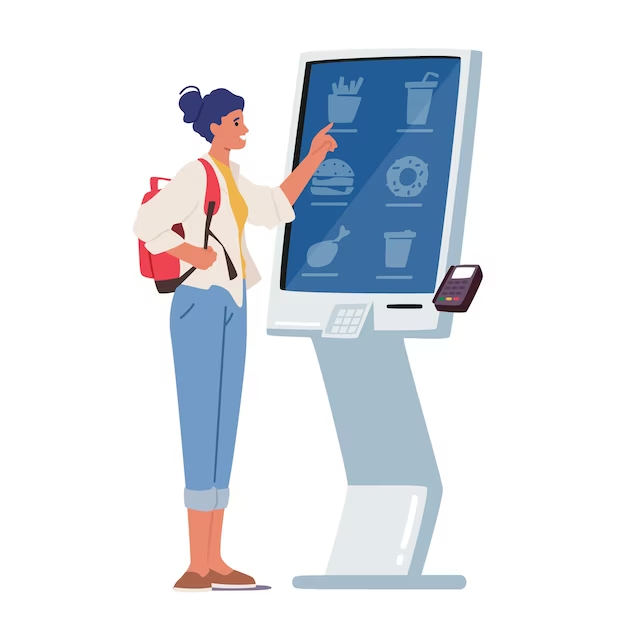Self-Ordering Kiosks: Everything You Need to Know


Nico Ruggieri
May 1, 2023
3 min read
Self-ordering kiosks have become increasingly popular in recent years, with many business owners choosing to implement them in their establishments. With advancements in technology and automation, self-ordering kiosks are now a viable option for small businesses looking to improve their operations and provide a better customer experience.
While these kiosks can offer several advantages, they also have some potential drawbacks.
In this article, we'll explore the benefits of self-ordering kiosks for small businesses and how they can help to increase efficiency, reduce wait times, and improve order accuracy. We'll also provide tips for selecting and implementing self-ordering kiosks in your small business.
What Are Self-Ordering Kiosks?
Self-ordering kiosks are automated machines that allow customers to place orders for products or services without the need for human interaction. These kiosks are commonly used in restaurants and retail stores, but can also be found in other industries such as healthcare and transportation. Their use is growing across many industries.
Self-ordering kiosks typically consist of a touch screen display where customers can select the products or services they wish to purchase. Customers can customize their orders by selecting options such as size, toppings, and extras.
Once the order is complete, customers can pay using a variety of payment methods, such as credit or debit cards, mobile payments, or cash.
Where Do They Make Sense?
While self-ordering kiosks could work in a number of industries, here are a few where they could particularly be useful:
- Fast Food Restaurants: Self-ordering kiosks are a perfect fit for fast food restaurants where customers are often in a hurry and prefer a quick and efficient ordering process.
- Retail Stores: Self-ordering kiosks can be used in retail stores to allow customers to purchase products directly from the kiosk. This can help to reduce wait times at checkout and improve the overall shopping experience.
- Healthcare: Self-ordering kiosks can be used in healthcare settings to allow patients to check in, schedule appointments, and pay for services.
- Entertainment Venues: Self-ordering kiosks can be used in movie theaters, amusement parks, and other entertainment venues to allow customers to purchase tickets and concessions.
Benefits of Self-Ordering Kiosks
Here are some advantages a small business gains by adopting this technology.
1. Increased Efficiency
Self-ordering kiosks help reduce lines and wait times by allowing customers to place their own orders quickly and easily. This can help increase the speed of service and overall efficiency of the establishment.
2. Improved Order Accuracy
By placing their own orders, customers are less likely to make mistakes or miscommunicate their preferences to a server. This can help reduce errors and improve overall customer satisfaction.
3. Upselling Opportunities
Self-ordering kiosks can be programmed to suggest additional menu items or promotions to customers, potentially leading to increased sales.
4. Reduced Cost of Labor
By allowing customers to place their own orders, business owners may be able to reduce their staffing needs and save on labor costs.
Potential Drawbacks of Self-Ordering Kiosks
Each business is unique, so here are some things to consider if you were to implement these technologies.
1. High Upfront Costs
Self-ordering kiosks can be expensive to install, with costs ranging from a few thousand dollars to tens of thousands of dollars, depending on the complexity of the system and the number of kiosks required.
2. Maintenance Costs
Like any technology, self-ordering kiosks require regular maintenance and occasional repairs. Business owners should factor in these ongoing costs when considering whether to invest in kiosks.
3. Technical Issues
Technical glitches and malfunctions can occur, which may cause frustration for customers and disrupt service. Business owners should have a plan in place to address these issues promptly—otherwise they could lose sales.
4. Reduced Human Interaction
Some customers may prefer interacting with a server or cashier and may feel uncomfortable using a kiosk. Additionally, some businesses may prioritize providing a unique customer experience that is difficult to deliver with kiosks.
Additional Features to Consider
Self-ordering kiosks can be an effective tool for helping customers find the right product in a few ways:
- Interactive menus: Self-ordering kiosks often have interactive menus that allow customers to browse through all available products and see their descriptions, prices, and images. This can help customers find the product they're looking for quickly and easily.
- Customization options: Many self-ordering kiosks allow customers to customize their orders to their specific preferences. For example, if a customer is looking for a vegetarian option, they can filter the menu to only show vegetarian items.
- Recommendations and suggestions: Self-ordering kiosks can be programmed to suggest products based on a customer's previous orders or popular items.
- Detailed information: Self-ordering kiosks often provide detailed information about products, including ingredients, nutritional information, and allergen warnings.
What POS products make the most sense for your business? Contact us today to learn the number of ways we can make your life running a small business easier.
